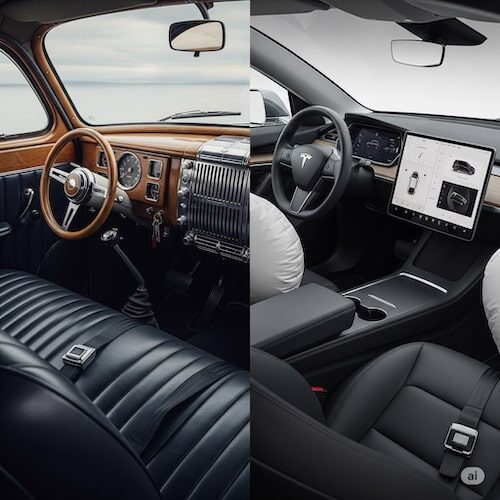Not long ago, before today’s safe driving inventions reshaped the roads, driving was all about gears, grit, and gut instinct. Cars were mechanical, and every decision, from braking to navigating, relied entirely on human input. But eight breakthrough inventions changed all of that. Some saved lives. Others changed how drivers see, think, and react. And together, they shaped what we now call modern mobility.
India loses over 1.8 lakh lives annually to road accidents, but imagine how much worse it would be without the safety innovations of the past century. As India rapidly modernises its roads and regulations, these driving safety innovations continue to remain deeply relevant. Not only in how they impact today’s driving experience but also in how they laid the groundwork for tomorrow’s intelligent safety systems.
At Attento Technologies, we are building on this legacy. By combining AI, driver monitoring, and real-time insights, we’re shaping the next generation of safety-first driving. But first, a look at the inventions that made it all possible.
1. 3-Point Seat Belts: The Safety Standard That Buckled Down on Risk
In 1959, Volvo engineer Nils Bohlin introduced the modern 3-point seat belt securing both the upper and lower body in a single, intuitive motion.
Before seat belts, high-speed collisions often resulted in serious injury or death. This simple invention is credited with reducing fatalities by up to 50% in frontal crashes. Today, it’s the gold standard of passive safety.
Under Section 194B of the Motor Vehicles Act, seat belts are mandatory for all passengers in India including rear-seat occupants, following a 2019 amendment.
Did You Know?
Volvo made the seat belt patent free, estimating it could save over 1 million lives. This decision cost the company billions in licensing revenue — but changed automotive safety forever.
2. Airbags: The Rapid Response System That Became a Life Saver
Although patented in the 1950s, airbags didn’t become widespread until the 1990s, after safety regulations and crash testing became more rigorous globally.
Airbags deploy within milliseconds to protect drivers and passengers from impact. When paired with seat belts, they significantly reduce head and chest injuries in serious collisions.
As of January 1, 2022, India mandates two airbags – for the driver and front passenger – in all passenger vehicles. The government also recommends six airbags under AIS-145 safety norms, though this isn’t mandatory yet.
Did You Know?
Early airbag prototypes deployed with such force they could injure or even eject crash test dummies. It took decades of refinement to make airbags both safe and effective.
3. ABS: Brakes That Think Before You Do
Anti-lock Braking Systems (ABS) were originally developed for aircraft in the 1920s. They entered the automotive mainstream in the 1980s after technological improvements made them reliable for consumer vehicles.
ABS prevents the wheels from locking up under hard braking, allowing the driver to maintain steering control. This is especially important on India’s varied road surfaces, from rain-slick highways to loose gravel.
ABS has been mandatory in India since April 2019 for all new passenger cars and two-wheelers above 125cc, under guidelines issued by the Ministry of Road Transport and Highways (MoRTH).
Did You Know?
ABS was once controversial, some drivers believed it made braking feel less “natural.” Today, it’s a foundational feature in modern vehicles and a stepping stone to even smarter systems like Electronic Stability Control (ESC).
4. ADAS: The Digital Copilot Revolutionizing Driving
Advanced Driver Assistance Systems (ADAS) emerged in luxury vehicles in the early 2000s. These include features like lane departure warnings, adaptive cruise control, blind spot alerts, and automatic emergency braking.
ADAS moves safety from reactive to proactive. By actively monitoring driver behavior, road conditions, and vehicle surroundings, these systems intervene before accidents happen — which is the vision behind Attento’s own AI-driven solutions.
ADAS is not yet a legal requirement in India. However, several automakers are voluntarily adding Level 1 and Level 2 ADAS capabilities to top-end and even mid-range models, signaling growing demand.
Did You Know?
Studies by the McKinsey Centre for Future Mobility show that ADAS-equipped vehicles can reduce crash rates by up to 40% — and insurers are starting to take notice.
5. GPS Navigation: The Satellite-Powered Sense of Direction
Global Positioning System (GPS) was created by the U.S. Department of Defence in the 1970s and became available for public use in the 1990s. It has since become a core part of modern mobility.
GPS eliminated the need for paper maps, enabling real-time navigation, rerouting, and traffic forecasting. In India, it powers everything from ride-sharing apps to smart logistics systems.
India is developing its own satellite navigation system — NavIC — which is expected to be integrated into mobile phones and vehicles as an alternative to GPS. The Indian government has encouraged auto manufacturers to include NavIC support in new models.
Did You Know?
The earliest in-car GPS units were bulky, slow, and cost over ₹1 lakh. Today, most smartphones and infotainment systems include satellite navigation as a free feature.
6. Rearview Mirrors: The Simple Invention That Changed Driver Awareness
The first recorded use of a rearview mirror was in 1911 by racecar driver Ray Harroun during the Indianapolis 500. By 1914, it was included in production vehicles and quickly became standard worldwide.
Rearview mirrors gave drivers a clear view of traffic behind them — dramatically improving lane changes, reversing, and overall situational awareness. They are considered the first major visual aid in car design.
According to AIS-001 and CMVR norms, all vehicles in India must include both internal (IRVM) and external (ORVM) mirrors. Driving without functional mirrors is a fineable offense.
Did You Know?
Ray Harroun’s rearview mirror idea helped him win the 1911 Indy 500 — by allowing him to race solo, while other cars needed two drivers (one to drive, one to spot from behind).
7. Crash Test Dummies: Measuring Impact Before It Happens
First developed in the 1970s, crash test dummies simulate the human body in collisions and are now standard in global automotive safety testing.
Dummies made it possible to measure injury risk with precision. Their data has shaped the design of seat belts, airbags, and crumple zones — saving millions of lives in the process. Modern dummies can record over 30,000 data points during a single crash test — from chest force to neck torque.
India follows Global NCAP testing protocols. Indigenous dummies are now being developed to better reflect the size and structure of Indian occupants.
Did You Know?
It was only in 2023, a Swedish research team introduced the first fully detailed female crash test dummy, called EvaRID, designed to model whiplash risk in female passengers.
8. Windshields: The Glass Shield That Does More Than You Think
While laminated windshields were patented in 1909, they only became standard in most production cars by the 1950s and 60s, following rising crash injuries and regulatory pressure.
Today’s windshields help maintain structural integrity, support airbags, and prevent ejection during collisions. They’re also crucial for mounting ADAS sensors like cameras.
Under AIS-037, laminated windshields are required in all Indian passenger vehicles and must meet impact and visibility standards.
Did You Know?
Your windshield supports up to 30% of your car’s roof strength — making it essential in rollover protection.
From Invention to Intelligence
These eight inventions didn’t just improve car safety — they redefined what safety means. From structural components like windshields to testing innovations like crash dummies, every advancement has moved us closer to a world where mobility is both efficient and humane.
But the road ahead won’t be shaped by parts alone. It will be shaped by behaviour, incentives, and smart technology that adapts to how we really drive.
At Attento, we’re turning that philosophy into action — with a mobile-first platform that transforms good driving into something measurable, social, and rewarding. Because the next big leap in safety won’t be what’s built into the car. It’ll be what’s built into the driver.












